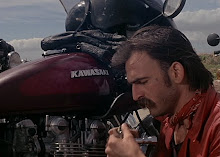Few can claim to have built a bike from the ground up. One of the people who can claim to building his own bike is Kiwi madman John Britten.
With a little help from his friends in Christchurch, New Zealand, Britten built a revolutionary bike that went on to beat the factories and set a few land speed records.
The number of parts not bespoke to the Britten V1000 are few. The brakes come from Brembo, the suspension from Ohlins, the clutch from Kawasaki and the transmission from Yamaha. And that's about it. The rest of the bike is completely handmade in Britten's workshop.
What makes the bike extraordinary is not just that it was handmade but the tech it incorporates. Let's start at the front. Where the vast majority of racing motorcycles use a hydraulic fork, the Britten V1000 uses a Hossack-style fork with twin control arms. For reference, the Hossack suspension is marketed by BMW as the Duolever and is found on the K1200/K1300 line of bikes.
The trump cards for this design are the elimination of brake dive and its strength. A hydraulic fork not only dives under braking but the forks tend to wiggle under the strain. This system doesn't.
What's so special about this setup if BMW is using it? Britten was using this suspension in 1991, 14 years before BMW used it. Also, Britten's front suspension is made entirely from carbon fiber, not aluminum like BMW's. The unit can have an amount of brake dive tuned it, to give the rider a sense of familiarity under braking.
Let's move back toward the engine. A v-twin design was chosen because it lessens the frontal area, improving aerodynamics, and a 60° spread was chosen to keep the wheelbase short. The powerplant is fairly straightforward: it's a liquid-cooled DOHC unit with four valves per cylinder. The rods are titanium and it has two injectors per cylinder. This engine churns out 165 hp and redlines at 12,500 rpm.
A stand out part of the engine is the exhaust. The wiggling spaghetti-like exhaust is made by hand and takes 70 hours to make. It's then coated in a nice shade of blue.
As we moved back to the engine, I can hear you asking about the radiator. It's liquid-cooled, where's the rad? I'm glad you asked. The rad is located under the seat, another Britten innovation.
And while we're here, let's talk about the frame. There isn't one. Everything bolts to the engine; the steering head, the swing arm the seat, everything. There is a little bit of "frame" that holds the front suspension together. It's made from carbon fiber, but I guess you've figured that out already.
Finally, the swing arm attaches to the back of the crank case, as does the seat. The arm is made of carbon fiber, too. Another weird thing to notice is the shock unit in front of the engine. No, that's not for the front. That's the rear shock.
The body work is carbon fiber, as are the wheels and the timing covers. I think the tires would have been made from carbon fiber if that was possible.
So this bike was very innovative, but what does all that mean? Well, it means the bike was fast, very fast. The V1000 competed from 1991 until 1994 and won three Battle of the Twins events, it won the NZ Grand Prix title in 1993 and came 1st and 2nd in the New Zealand National Superbike Championship in 1994.
This machine also has a number of speed records to its name, including a top speed record at the Isle of Man TT in 1993. That same year, the V1000 set the speed record for the flying mile, the quarter mile from a standing start, the mile from a standing start and the kilometer from a standing start.
As with anything good, there also comes a side of bad. The V1000 was no different. The small shop run by Britten kept the bike out of major world competition. World Superbike requires 200 examples to be sold to enter the series. Between 1991 and 1994, only 10 Britten V1000s were produced. This limited the types of races in which the bike could be entered.
Perhaps the biggest blow to the V1000 was the death of John Britten in 1995. With him went the company and the dream.
The V1000 isn't noted just for its innovation. It's noted for being the result of a group of people dedicated to creating something truly wonderful. It's also noted for having the ability to go out and beat the factories. I think the V1000 resonates with many motorcyclists because it is the story of a man literally building a bike in his shed that goes out and not only takes on the world, but beats it. The human story outside of the bike, I think, is the most interesting part.
It's wonderful to see Honda, Yamaha, etc. spend millions to push the envelope. It's even better when it happens in someone's backyard through their vision, genius and willpower.
Subscribe to:
Post Comments (Atom)

Cool post. A photo would be nice!
ReplyDelete